Bond line forming method
a technology of bond line and forming method, which is applied in the manufacture of final products, machines/engines, wind energy generation, etc., can solve the problems of increasing the cost and weight of the rotor blade, and using uncontrollable force to assemble the blade shell
- Summary
- Abstract
- Description
- Claims
- Application Information
AI Technical Summary
Benefits of technology
Problems solved by technology
Method used
Image
Examples
Embodiment Construction
[0022]Reference will now be made in detail to the various embodiments of the invention, one or more examples of which are illustrated in the figures. Each example is provided by way of explanation of the invention, and is not meant as a limitation of the invention. For example, features illustrated or described as part of one embodiment can be used on or in conjunction with other embodiments to yield yet a further embodiment. It is intended that the present invention includes such modifications and variations.
[0023]FIG. 1 is a schematic view of a wind turbine 100. Wind turbine 100 has a tower 110 on which a machine nacelle 120 is mounted. Typically, machine nacelle 120 houses an electric generator, a gear box and a turbine control device (not shown). A wind rotor for converting kinetic wind energy into rotational energy is mounted to one end of nacelle 130. The wind rotor includes a hub 130 mounted to nacelle 130 in a rotatable manner so that it can rotate about a horizontal axis. F...
PUM
| Property | Measurement | Unit |
|---|---|---|
| Adhesivity | aaaaa | aaaaa |
Abstract
Description
Claims
Application Information
 Login to View More
Login to View More - R&D
- Intellectual Property
- Life Sciences
- Materials
- Tech Scout
- Unparalleled Data Quality
- Higher Quality Content
- 60% Fewer Hallucinations
Browse by: Latest US Patents, China's latest patents, Technical Efficacy Thesaurus, Application Domain, Technology Topic, Popular Technical Reports.
© 2025 PatSnap. All rights reserved.Legal|Privacy policy|Modern Slavery Act Transparency Statement|Sitemap|About US| Contact US: help@patsnap.com



